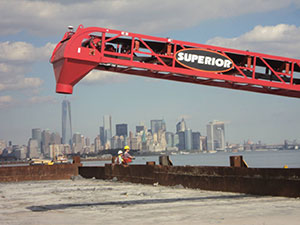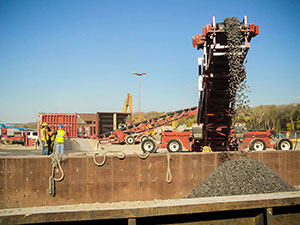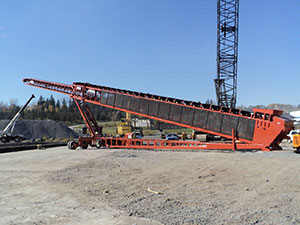Rollin’ on the river
The Port of Coeymans is engineered for efficient bulk material handling and transport.
Along the Hudson River in upstate New York, the Port of Coeymans is a rapidly growing, full-service marine terminal located about 10 miles south of Albany and 110 miles north of New York City. The 400-acre port is privately owned by Carver Cos., which includes a construction and a sand-and-gravel division. For Carver Sand & Gravel, an aggregate operation with nine locations in four counties, the port offers the advantage of direct access to 3,500 ft. of riverfront property with the ability to ship large volumes of material on barges, while freeing up the roads from significant truck traffic and providing a considerable savings to its customers.
In addition to shipping its aggregate products for bridge, highway and large-scale landscaping products, the terminal leases acreage and warehouse space to more than a dozen other companies, and also offers deep-water shipping services. Shortly after its opening in 2009, the port became the assembly point for several New York City bridges, with a number of bridge components loaded on barges and shipped down the river to their construction sites. In its first full year of operation, the port handled an estimated 80,000 tons of cargo, with its second year seeing an increase to more than 900,000 tons. With the recent addition of new conveyor systems that streamline material handling and loading processes, the port is poised for growth.
“In the future, we will ship anywhere from 1 million to 3 million tons of cargo per year from this port,” says Carver Cos. President Carver Laraway, who owns the port along with his partner, Eli Weis, a real estate developer. Recently, Carver Sand & Gravel won the job of supplying and shipping more than 500,000 tons of aggregate for use in the dredging portion of a high-profile New N.Y. Bridge project, a new 3.5-mile twin-span bridge that crosses the Hudson River. Scheduled for completion in 2018, the $3.9 billion bridge will replace the Tappan Zee toll bridge that opened in 1955.
Carver Sand & Gravel is processing material for the dredging project at a quarry location adjacent to the Port of Coeymans. The aggregate material is being shipped via barge to the bridge-dredging site, where Weeks Marine is removing just under 1 million cu. yds. of material. Dredging was required to create enough depth for cranes and other equipment used in building the bridge so that workers can navigate the site during bridge construction. Weeks Marine is capping the dredge site with sand and stone coming from the Port of Coeymans.
Founded in 1919, Weeks Marine is an international dredging, construction and shipping company. Among its many projects, Weeks Marine has hauled debris away from the World Trade Center after the 9/11 attacks; salvaged the U.S. Airways plane that Captain Chesley Sullenberger landed in the Hudson River; and carried NASA’s Space Shuttle to the Intrepid Sea, Air & Space Museum on Manhattan’s West Side.
Efficient material handling
Important to the efficiency of both the aggregate material transport and its use in the dredging project is the utilization of two TeleStacker conveyors, manufactured by Superior Industries. Customized to fit the exacting requirements of each marine application, these conveyor systems can be seen as “bookends” around the dredging project. The TeleStacker conveyor at the port streamlines the barge-loading process. Once the aggregate material travels down the river and arrives at the dredging site, Weeks Marine uses its TeleStacker conveyor to precisely and evenly convey the material into the river.
Prior to the installation of the TeleStacker conveyor at the port, Laraway says that he was concerned about the multiple handling of the material. “Trucks would come to the dock and dump the aggregate material on the ground. A loader and an operator would push up the piles, while a material handler and an operator would scoop it up and load it on the barge. So I had two workers and two pieces of equipment using seven to 10 gallons of fuel per machine. Go ahead and do the numbers,” he says.

At a dredging site, Weeks Marine uses its TeleStacker conveyor to precisely and evenly deposit material into the river.
Laraway consulted with Rod Dibble, owner and president of Dibble Equipment LLC, an East Schodack, N.Y.-based equipment dealership, and the representative for Superior Industries in that region. As a longtime construction equipment sales engineer, Dibble had worked with Laraway in the past. “Rod is second to none, and Superior is a great company to work with,” Laraway says. “They are a team. When they say they will do something, they get it done.”
The material handling and loading system allows trucks to dump 50- to 70-ton loads into a hopper, which feeds a transfer conveyor. The latter feeds a 3.5-ft. x 170-ft. TeleStacker conveyor. Mounted on a concrete pad, the unit’s radial and telescopic capabilities allow the loading of up to three barges without having to move any of them during the process. Barge lengths range from 195 to 260 ft., and loading times average three hours or less.
“The system is also designed so that we have the future flexibility to unload barges at the port by feeding the hopper from a barge and then turning the TeleStacker conveyor so that it can discharge into a second hopper for loadout,” says Laraway, adding that the whole project has come off flawlessly. “By eliminating costly loader use and multiple material handling, we have cut our costs by about $1 per ton. With future projected shipments of 2 million tons per year, that is some serious savings.”
An optimized process
Weeks Marine is also pleased with the added material-handling efficiencies on their end of the project. “Traditionally, contractors have used a clamshell bucket to spread material on the river bottom, but we really thought that a conveyor would be the best way to apply the material,” says Weeks Marine Project Manager Adam Wallach. “A number of conveyors we looked at would not fit our requirements. Then we met with Rod Dibble and Superior Industries, and we saw that their unit would handle the application and would yield the feed rate we needed.”
Wallach says Superior customized the TeleStacker conveyor to fit the footprint of its 160-ft. x 74-ft. barge that is used at the dredge site. “It is mounted on a pin, and operates on a wheeled pivot base so our operator can remotely use its radial and telescopic capabilities to lay the material evenly in a given area. It’s a very clever and efficient setup,” says Wallach, adding that because the system is portable, the company is targeting other projects for its use.
As more and more companies access water transport methods to increase volume and cut costs, the need for equal cost efficiencies in material handling, loading and unloading methods will complete the picture. Having one without the other may mean producers are leaving profit margins at the bottom of the stockpile.
Take note
Mounted on a concrete pad, the TeleStacker conveyor’s radial and telescopic capabilities allow the loading of up to three barges without having to move any of them during the process. Barge lengths range from 195 to 260 ft., and loading times average three hours or less.
Carol Wasson is a veteran freelance writer for the aggregates and construction equipment industries.
Photo: The Port of Coeymans












